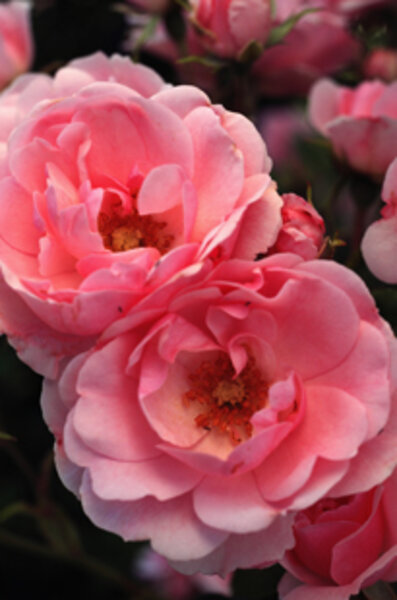Roses that put the ‘easy’ back in easy living
Loading...
It was Gertrude Stein who wrote “a rose is a rose is a rose.”
With all due respect, Gertrude couldn’t have been much of a gardener because the rose world is actually filled with mind-boggling variety.
There are micro-minis with blooms smaller than a pencil eraser and 18th-century roses covered with fragrant moss. There are showy hybrid tea blooms with their spiraling high centers and rambling roses with canes that stretch out 25 feet.
Now, for those people who were thinking a rose by the mailbox might be pretty, this is probably way too much information.
You don’t want to plant a formal rose garden or enter a hybrid Gallica in a local rose show. You just want a dependable plant that doesn’t need to be coddled. One that will reward you with color, perhaps a touch of fragrance, and maybe even attractive rose hips (colorful fruit) in the fall.
Fortunately for those who desire the charm of roses without the hassle, such plants do exist: Shrub roses.
The classification “shrubs” can be confusing because it lumps all kinds of roses into a single category. But even though these plants vary widely in appearance, depending on the variety, they can serve in any capacity from colorful ground covers to climbers.
Roses make a comeback
The idea of roses mingling with neighboring plants in the landscape is a fairly recent one. In days gone by, the queen of flowers usually lived in separate beds.
Then garden designers realized that perennials and other plants could actually hide some of the unattractive aspects of a rose, mainly the canes, or “bare legs,” as the renowned garden writer Christopher Lloyd observed.
Lloyd and others thought that roses were too labor-intensive and might best be left out of the garden completely. For a time, many rosebushes ended up in the trash pile.
Then a new generation of shrubs came along that put roses back in the garden for good.
Traditionally, shrub roses have been known for longevity, hardiness, and flower power. But once modern breeders were able to add disease resistance to the mix, their popularity soared.
Roses from France and England
The legendary French rose hybridizer, House of Meilland, was one of the first to combine beauty with low maintenance. The firm that gave the world the Peace rose introduced Bonica in 1985. It’s easy to grow and an ideal choice for beginners.
Each bush sports masses of ruffled pink blooms all season and can spread five feet in width, making it a great choice for a low hedge. Bonica was the first shrub rose to win the All-America Rose Selection Award.
At the same time Bonica was redefining the shrub rose, Englishman David Austin was creating a “new” old-fashioned rose.
His English roses combine the fragrance and charm of old garden roses grown prior to 1867 with modern vigor and repeat bloom. The pure apricot Grace and light-pink Heritage are particularly impressive in a grouping of three.
Other highly rated recent shrub introductions include Lyda Rose, a charming, vigorous bush with blooms that resemble apple blossoms. It is disease-free and can tolerate some shade.
The 1991 rugosa rose Linda Campbell features brilliant clear red blooms with as many as 25 blossoms per stem. Growing to a statuesque six feet, Linda is a perfect showoff in the garden.
Another gorgeous garden girl is multiple award winner Sally Holmes. Her pointed, peachy buds unfurl to reveal creamy single blooms that almost always come in huge clusters. Sally is a medium to large specimen, depending on the climate in which she’s grown.
Of course, it was the introduction of the Knock Out line of roses that allowed gardeners to use the words “carefree” and “rose” in the same sentence. Virtually
disease-free, they are truly plant-and-forget bushes.
Gardeners who shied away from roses are having success with Knock Out beyond their wildest dreams. And they are now emboldened to try other shrub roses.
Other easy-care choices
Given all the hoopla over Knock Out, American Rose Society horticultural judge Bill Blevins reminds us not to overlook some of the older garden roses such as Rosa Rugosa alba (single white blooms) and ruber (mauve pink with yellow stamens.)
“They bloom all season even in windy coastal areas and are almost never troubled by disease,” he says. “And they’re covered with beautiful red hips in the fall.”
Mr. Blevins also recommends a newer shrub rose, Belinda’s Dream (pink), which has received the Earth Kind designation for disease resistance.
Another favorite is the 1901 introduction, Roseraie de L’Hay – a vigorous shrub with crimson-purple flowers and disease-free, apple-green foliage. It grows an impressive seven feet by seven feet, and the strong perfume of its blossoms draws admirers from afar.
Many of the roses described here can be found at local garden centers and nurseries. Others can be ordered online.
Any of them are good choices for wannabe gardeners not blessed with a green thumb. Or for those who simply want to put more “easy” in easy living.





